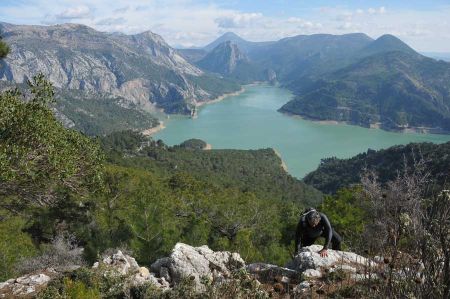Laurel forests line the way - hiking tour
- Written by Portal Editor
Once again it was time. Our dear friend and hiking guide Ömer had invited us to another excursion through the coastal Taurus Mountains near Manavgat above the Oymarpinar dam.
In the early morning we first drove by car from Manavgat in the direction of Oymapinar Dam, then left on a winding road up into the Taurus to the village of Avasun, which seemed almost deserted. We parked the vehicle in the middle of the village square, which, as we were to find out after our return, wasn't so deserted after all. In schoolboy writing it was written: Wash me! In any case, the student authors were right, but the slope was really too dusty.
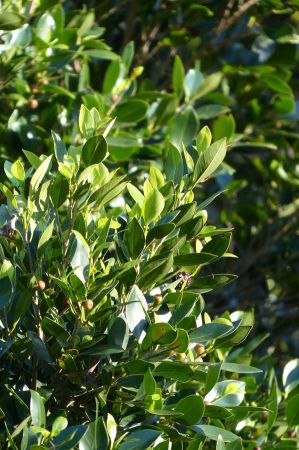 Ömer now led us first over relatively flat terrain, which was used by the farmers up here in the frame of small fields, which were surrounded by stone walls and used for planting grain and legumes. The partially ancient separation between footpaths and fields by the stacked stone walls was still clearly visible. The erection of a modern concrete fence, on the other hand, was puny, which had simply fallen over almost 70 meters due to poor foundations.
Ömer now led us first over relatively flat terrain, which was used by the farmers up here in the frame of small fields, which were surrounded by stone walls and used for planting grain and legumes. The partially ancient separation between footpaths and fields by the stacked stone walls was still clearly visible. The erection of a modern concrete fence, on the other hand, was puny, which had simply fallen over almost 70 meters due to poor foundations.
Still at the edge of the village, Ömer drew our attention to the most important product of this village, which was stored in large bundles of bushes on some areas: real laurel, sometimes also called noble laurel or spice laurel. We know the real laurel in its use as a spice plant, because the aromatic leaves of the laurel tree are ideal for use as a seasoning for soups, stews, meat dishes or fish. A bay leaf is often added to the trout to be grilled. When Ömer asked, we also thought of using it for pickled cucumbers or herring, and bay leaves are also often added when making aspic.
Laurel in the Taurus - cultivation area, used for centuries
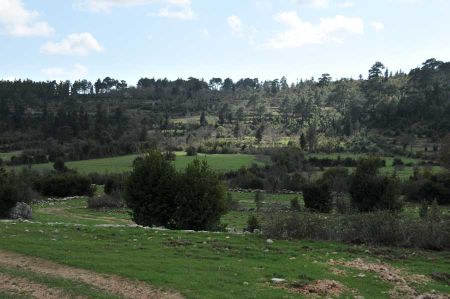 Even today, mountain farmers use the fruits of the laurel tree, which are called Fructus Lauri, as an antiparasitic to get rid of lice or itch mites. In Europe, too, these applications were at least known until they stopped using them due to allergic contact dermatitis, which often occurs as a side effect. Fructus Lauri is still used today in the treatment of dairy cattle with udder diseases. To do this, the laurel fruits are pressed out, resulting in a buttery, greenish mass that consists of about 95% fatty oils and about 5% essential oils, the Oleum Lauri. Almost like a cream, laurel oil is used medically for rubbing in on bruises, sprains and rheumatic complaints. Plant species with aromatic leaves, often referred to as laurel, can be found all over the world. In most cases, however, these leaves hardly have any resemblance to real laurel in terms of taste, and they are not used as effectively as a medicinal or spice plant.
Even today, mountain farmers use the fruits of the laurel tree, which are called Fructus Lauri, as an antiparasitic to get rid of lice or itch mites. In Europe, too, these applications were at least known until they stopped using them due to allergic contact dermatitis, which often occurs as a side effect. Fructus Lauri is still used today in the treatment of dairy cattle with udder diseases. To do this, the laurel fruits are pressed out, resulting in a buttery, greenish mass that consists of about 95% fatty oils and about 5% essential oils, the Oleum Lauri. Almost like a cream, laurel oil is used medically for rubbing in on bruises, sprains and rheumatic complaints. Plant species with aromatic leaves, often referred to as laurel, can be found all over the world. In most cases, however, these leaves hardly have any resemblance to real laurel in terms of taste, and they are not used as effectively as a medicinal or spice plant.
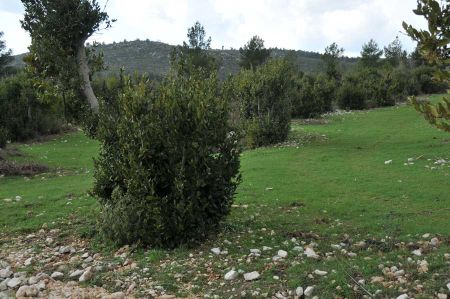 During all the descriptions and explanations, we have long since left the village surroundings. Then meet the first laurel bushes along the way, whose "processing" by human hands is clearly recognizable. Common laurel is usually an evergreen shrub or tree that can grow up to 10 meters tall. Our first specimen, on the other hand, is only 3 meters high.
During all the descriptions and explanations, we have long since left the village surroundings. Then meet the first laurel bushes along the way, whose "processing" by human hands is clearly recognizable. Common laurel is usually an evergreen shrub or tree that can grow up to 10 meters tall. Our first specimen, on the other hand, is only 3 meters high.
Ömer is there again soon and explains the situation. The mountain farmers cut the young shoots and twigs along with the leaves from the trunk, which are then bundled into bushes and carried to the village. Here the leaves are then "picked" from the twigs and shoots in a joint action by the villagers. Tons of bay leaves then lie on the fields in the village, so that the leathery leaves, which are shiny on the top, spread an aromatic scent over the whole village.
Let your food be your medicine and your medicine your food.
The most famous physician in antiquity, the Greek physician Hippocrates of Kos, recommended this rule as early as the 5th century BC.
Bushes and shrubs - companions made of laurel
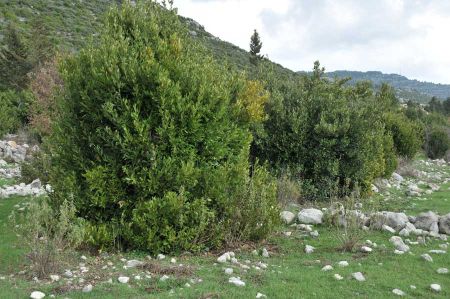 Many of us have probably known the laurel wreath since the stories about Asterix and the Romans. The ancient Greek term for laurel was "daphne" (in Turkish "defne"), so that one finds the following connection in mythology: in order to escape Apollo's snares, the nymph Daphne transformed into a laurel bush. From now on, Apollo wore a laurel wreath twisted with twigs as a sign of his grief over his unrequited love for Daphne. As always when dealing with topics from mythology, little is known about the sources or origins of the stories. It is at least possible that the leaves of the real laurel, which are consumed in large quantities, lead to trance and disturbances of consciousness. So the historians suspect, not entirely without a background, that the visions of the priestesses of the oracle of Delphi can also be traced back to the consumption of laurel.
Many of us have probably known the laurel wreath since the stories about Asterix and the Romans. The ancient Greek term for laurel was "daphne" (in Turkish "defne"), so that one finds the following connection in mythology: in order to escape Apollo's snares, the nymph Daphne transformed into a laurel bush. From now on, Apollo wore a laurel wreath twisted with twigs as a sign of his grief over his unrequited love for Daphne. As always when dealing with topics from mythology, little is known about the sources or origins of the stories. It is at least possible that the leaves of the real laurel, which are consumed in large quantities, lead to trance and disturbances of consciousness. So the historians suspect, not entirely without a background, that the visions of the priestesses of the oracle of Delphi can also be traced back to the consumption of laurel.
Under the Romans, when entering the city of Rome, the general was crowned with a laurel wreath. With the transition to the German Empire, the Corona Triumphalis also became official jewellery when appearing in public. Later, the winners of the games or competitions received a wreath of laurel leaves as a special award. Even today, the laurel wreath is considered a symbol of glory or victory, but also a symbol of peace.
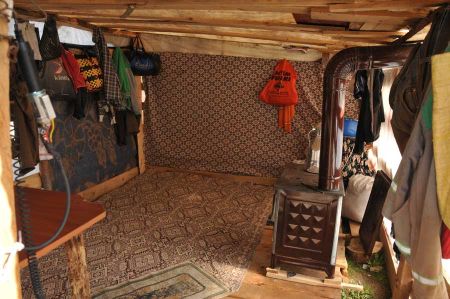 In the meantime, we had long since reached the transition to the pine forests and Ömer led us along goat paths higher and higher into the mountains. Further up we came upon a lumberjacks' camp, a camp consisting of family dwellings of the simplest construction, where Turkish lumberjacks lived together with their wives. Usually, the women went about their daily activities, such as washing clothes and cooking, while the men cut down previously marked trees. Quite relaxed we were able to examine the "one-room houses" erected in the quick-build, which were presented to us without hesitation as clean and really tidy. In general, the people we met were extremely friendly and relaxed.
In the meantime, we had long since reached the transition to the pine forests and Ömer led us along goat paths higher and higher into the mountains. Further up we came upon a lumberjacks' camp, a camp consisting of family dwellings of the simplest construction, where Turkish lumberjacks lived together with their wives. Usually, the women went about their daily activities, such as washing clothes and cooking, while the men cut down previously marked trees. Quite relaxed we were able to examine the "one-room houses" erected in the quick-build, which were presented to us without hesitation as clean and really tidy. In general, the people we met were extremely friendly and relaxed.
Loads of flatbread were stored on a pick-up truck, which had been prepared for sale in the next village with a market and for self-consumption. We were absolutely surprised when, almost hidden by all the bread, we came across a very modern commodity of our "civilized" world: photovoltaic cells. Take a look, was our thought. So far from any modern lifestyle but electricity in the cabin. It's sometimes fascinating how, despite all your prejudices, you keep surprising yourself.
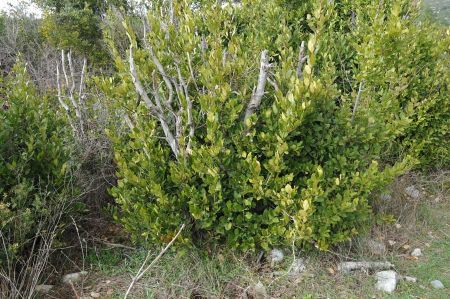 Ömer was already urging us to leave, because only about 500 meters away there was another highlight of today's tour, the view of the Oymarpinar reservoir from far above. Indescribable.
Ömer was already urging us to leave, because only about 500 meters away there was another highlight of today's tour, the view of the Oymarpinar reservoir from far above. Indescribable.
So it took us quite a while just to process this phenomenal view: the shimmering blue reservoir with the deep green forests around it, in the background the snow-capped 3,000m peaks of the Taurus Mountains. It was really beautiful, so we stayed for a while. In general, it was here that we realized again how indescribably pleasant the climate was for spending time in nature.
It was always about 18 - 20° in the sun. And even in the shade of the trees, it was still too warm in the outdoor jacket.
The Romans who settled here also used the laurel
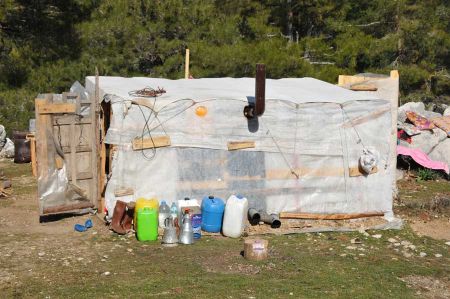 Now we went further up the mountain, because Ömer had already mentioned the mountain peak on the way, which the local population describes as an eagle's nest. There were hardly any goat paths here that could be used for inspection. Bushes partially blocked our way, but Ömer always found a passage for further ascent. The first massive, worked stones could already be seen, which clearly indicated a building from the earliest times in the remains of the wall. We also found some remains of pottery shards that could be classified as carafe handles or bulbous vessels based on their shape, including parts of roof tiles. Also, from clay. Just the thought of the arduous transport here suggested a Roman settlement or fortification. The fluting of some stones also seems to confirm our assumption. Perhaps this place was inhabited by people much earlier. As far as we know, there has never been any research into this.
Now we went further up the mountain, because Ömer had already mentioned the mountain peak on the way, which the local population describes as an eagle's nest. There were hardly any goat paths here that could be used for inspection. Bushes partially blocked our way, but Ömer always found a passage for further ascent. The first massive, worked stones could already be seen, which clearly indicated a building from the earliest times in the remains of the wall. We also found some remains of pottery shards that could be classified as carafe handles or bulbous vessels based on their shape, including parts of roof tiles. Also, from clay. Just the thought of the arduous transport here suggested a Roman settlement or fortification. The fluting of some stones also seems to confirm our assumption. Perhaps this place was inhabited by people much earlier. As far as we know, there has never been any research into this.
On the side facing away from the reservoir, we started our descent. The man-made terraces were clearly visible, sometimes only a few square meters in size. Now and then really precisely worked blocks of stone, which were set up to form walls in order to enlarge cultivated areas. Subsequent colonies never went to so much trouble. That became more and more clear to us.
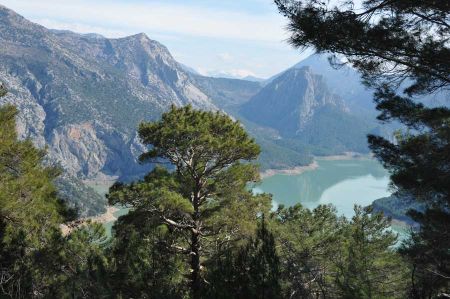 Further down we encountered goat trails again, which we now gratefully accepted to use. On the way we came across a large herd of goats grazing freely, who were particularly interested in the many herbs between the pines. Completely unsupervised, you could sometimes only hear the little bells of the goats in the dense bushes. Only further down in the direction of the village did we come across the farmstead of the goat farmer and were greeted by his dogs with correspondingly loud barking. In the subsequent conversation with the goat farmer, however, we were not able to find out why the dogs were not with the herd.
Further down we encountered goat trails again, which we now gratefully accepted to use. On the way we came across a large herd of goats grazing freely, who were particularly interested in the many herbs between the pines. Completely unsupervised, you could sometimes only hear the little bells of the goats in the dense bushes. Only further down in the direction of the village did we come across the farmstead of the goat farmer and were greeted by his dogs with correspondingly loud barking. In the subsequent conversation with the goat farmer, however, we were not able to find out why the dogs were not with the herd.
After a few more kilometers we had reached our starting point again. So we went back to civilization, where we prepared some trout due to our feeling of hunger, prepared salad and cooked bulgur. A delicious meal after a glorious hike through the Taurus, with some bay leaves in the fish of course. Yummy.
Hiking is one of the most beautiful ways to discover nature. Hiking trails lined with fragrant laurel bushes are particularly attractive. These Mediterranean forests offer a unique atmosphere and invite you to linger.
The meaning of laurel
Symbolism and history of laurel
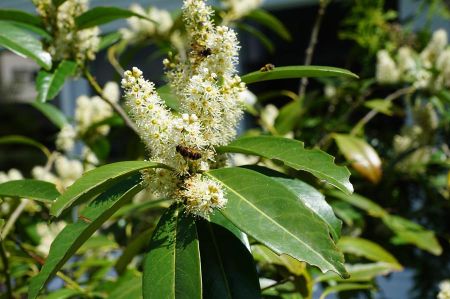 Laurel has had a special meaning for thousands of years. In ancient times it was considered a sign of fame and victory - Roman emperors and Greek athletes were honored with laurel wreaths.
Laurel has had a special meaning for thousands of years. In ancient times it was considered a sign of fame and victory - Roman emperors and Greek athletes were honored with laurel wreaths.
Use in ancient times and today
In addition to its symbolic meaning, laurel was used in medicine and cooking. Even today, bay leaves are an integral part of many dishes and natural remedies.
Laurel forests in the Mediterranean region
Typical locations
Laurel forests are found primarily in Mediterranean climates - from southern Europe to Turkey to North Africa.
Climate and growth conditions
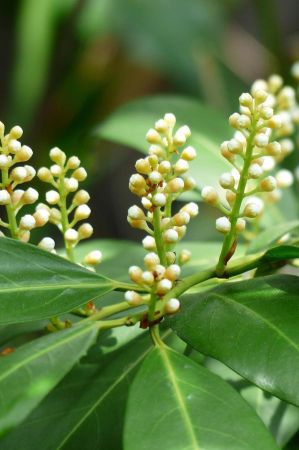 The evergreen laurel trees prefer moist, warm regions and thrive particularly well in sheltered valleys or on mountain slopes.
The evergreen laurel trees prefer moist, warm regions and thrive particularly well in sheltered valleys or on mountain slopes.
Hiking through laurel forests
The beauty of Mediterranean hiking trails
The combination of shady paths, the aromatic scent of laurel leaves and the variety of plants makes these hikes particularly attractive.
Important hiking areas with laurel trees
Flora and fauna along the trails
Mediterranean flora
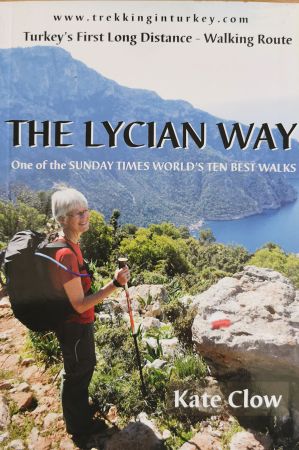 In addition to laurel trees, you often come across olive trees, myrtles, lavender and wild herbs on these hikes.
In addition to laurel trees, you often come across olive trees, myrtles, lavender and wild herbs on these hikes.
Animals that can be discovered on the hike
Birds such as hoopoes and bee-eaters, but also turtles and lizards are native to these regions.
The best hiking trails with laurel trees
Turkey: Lycian Way and Taurus Mountains
The Lycian Way offers breathtaking views of the sea and leads through lush laurel forests. The Taurus Mountains are also a paradise for hikers.
Greece: Samaria Gorge
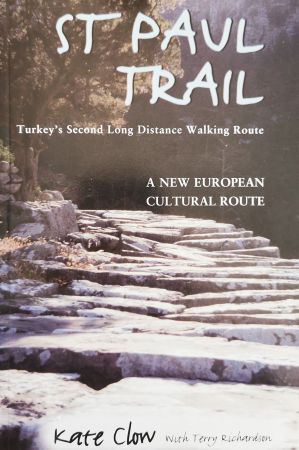 The famous gorge on Crete impresses with spectacular rock formations and lush vegetation.
The famous gorge on Crete impresses with spectacular rock formations and lush vegetation.
Spain: La Gomera (Canary Islands)
The Garajonay National Park is a UNESCO World Heritage Site and one of the most beautiful places to experience laurel forests.
Health benefits of hiking in laurel forests
Fresh air and relaxation
Hiking through these forests strengthens the lungs, calms the mind and offers a beneficial break from everyday life.
Effects of essential oils
Bay leaves contain essential oils that have a relaxing effect and clear the airways.
Tips for a successful hike
Best time to travel
Spring and autumn are the best seasons for hiking as the weather is pleasant and nature is in full bloom.
Important equipment
- Comfortable hiking shoes
- Water and snacks
- Sun protection and light clothing
- Camera for the impressive landscape
Culinary highlights with bay leaves
Traditional dishes with bay leaves
Bayle adds a special flavor to soups, stews and meat dishes. It is particularly popular in Mediterranean and oriental recipes.
How to use bay leaves correctly
The leaves should be dried and cooked to develop their full flavor. After cooking, they should be removed as they remain hard.
Sustainability and protection of laurel forests
Threats to laurel trees
Deforestation, fires and climate change are endangering many laurel forests.
How hikers can help protect them
- Do not damage plants
- Take rubbish with you
- Only use marked paths
Conclusion
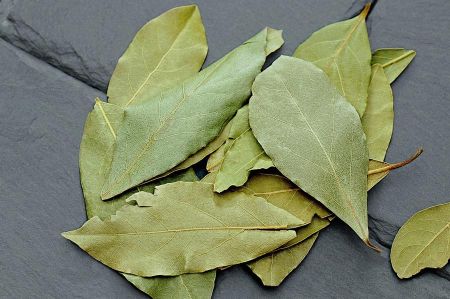 Laurel forests are a true paradise for nature lovers and hiking enthusiasts. Their beauty, scent and relaxing effect make them a special experience. Anyone who has ever walked through a laurel forest will never forget the magic of this landscape.
Laurel forests are a true paradise for nature lovers and hiking enthusiasts. Their beauty, scent and relaxing effect make them a special experience. Anyone who has ever walked through a laurel forest will never forget the magic of this landscape.
Frequently Asked Questions (FAQs)
1. Where can you find the most beautiful laurel forests?
- There are many impressive laurel forests in Turkey, Greece and the Canary Islands.
2. When is the best time to walk in laurel forests?
- Spring and autumn are ideal as the temperatures are pleasant.
3. Are bay leaves edible?
- Yes, they are often used as a spice but should not be eaten raw.
4. What animals can you see in laurel forests?
- Birds, turtles, lizards and sometimes even wild boars.
5. How can you protect laurel forests?
- By behaving respectfully, not leaving rubbish behind and not damaging plants.
Please read as well:
Backpackers - St Pauls Trail with Kate Clow
Akseki - Silk Road invites you to go hiking
-
 Hiking along Laurel bushes at Oymapinar
Hiking along Laurel bushes at Oymapinar
Hiking along Laurel bushes at Oymapinar
Hiking along Laurel bushes at Oymapinar
-
 Hiking along Laurel bushes at Oymapinar
Hiking along Laurel bushes at Oymapinar
Hiking along Laurel bushes at Oymapinar
Hiking along Laurel bushes at Oymapinar
-
 Hiking along Laurel bushes at Oymapinar
Hiking along Laurel bushes at Oymapinar
Hiking along Laurel bushes at Oymapinar
Hiking along Laurel bushes at Oymapinar
-
 Hiking along Laurel bushes at Oymapinar
Hiking along Laurel bushes at Oymapinar
Hiking along Laurel bushes at Oymapinar
Hiking along Laurel bushes at Oymapinar
-
 Hiking along Laurel bushes at Oymapinar
Hiking along Laurel bushes at Oymapinar
Hiking along Laurel bushes at Oymapinar
Hiking along Laurel bushes at Oymapinar
-
 Hiking along Laurel bushes at Oymapinar
Hiking along Laurel bushes at Oymapinar
Hiking along Laurel bushes at Oymapinar
Hiking along Laurel bushes at Oymapinar
-
 Hiking along Laurel bushes at Oymapinar
Hiking along Laurel bushes at Oymapinar
Hiking along Laurel bushes at Oymapinar
Hiking along Laurel bushes at Oymapinar
-
 Hiking along Laurel bushes at Oymapinar
Hiking along Laurel bushes at Oymapinar
Hiking along Laurel bushes at Oymapinar
Hiking along Laurel bushes at Oymapinar
-
 Hiking along Laurel bushes at Oymapinar
Hiking along Laurel bushes at Oymapinar
Hiking along Laurel bushes at Oymapinar
Hiking along Laurel bushes at Oymapinar
-
 Hiking along Laurel bushes at Oymapinar
Hiking along Laurel bushes at Oymapinar
Hiking along Laurel bushes at Oymapinar
Hiking along Laurel bushes at Oymapinar
-
 Hiking along Laurel bushes at Oymapinar
Hiking along Laurel bushes at Oymapinar
Hiking along Laurel bushes at Oymapinar
Hiking along Laurel bushes at Oymapinar
-
 Hiking along Laurel bushes at Oymapinar
Hiking along Laurel bushes at Oymapinar
Hiking along Laurel bushes at Oymapinar
Hiking along Laurel bushes at Oymapinar
-
 Hiking along Laurel bushes at Oymapinar
Hiking along Laurel bushes at Oymapinar
Hiking along Laurel bushes at Oymapinar
Hiking along Laurel bushes at Oymapinar
-
 Hiking along Laurel bushes at Oymapinar
Hiking along Laurel bushes at Oymapinar
Hiking along Laurel bushes at Oymapinar
Hiking along Laurel bushes at Oymapinar
-
 Hiking along Laurel bushes at Oymapinar
Hiking along Laurel bushes at Oymapinar
Hiking along Laurel bushes at Oymapinar
Hiking along Laurel bushes at Oymapinar
-
 Hiking along Laurel bushes at Oymapinar
Hiking along Laurel bushes at Oymapinar
Hiking along Laurel bushes at Oymapinar
Hiking along Laurel bushes at Oymapinar
-
 Hiking along Laurel bushes at Oymapinar
Hiking along Laurel bushes at Oymapinar
Hiking along Laurel bushes at Oymapinar
Hiking along Laurel bushes at Oymapinar
-
 Hiking along Laurel bushes at Oymapinar
Hiking along Laurel bushes at Oymapinar
Hiking along Laurel bushes at Oymapinar
Hiking along Laurel bushes at Oymapinar
https://www.alaturka.info/en/hiking-tours/6119-laurel-forests-line-the-way-hiking-tour#sigProIdcea7ae2216
